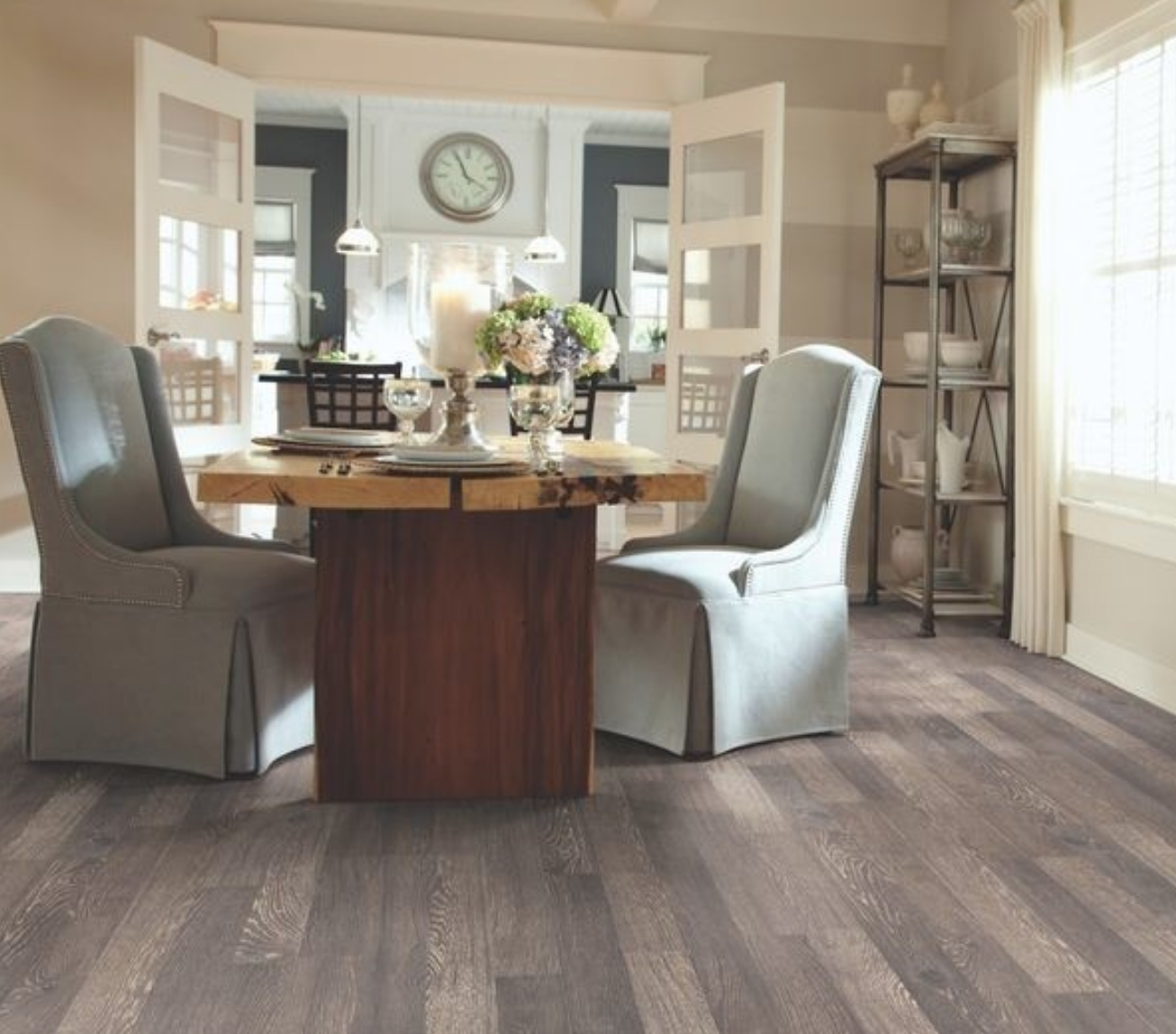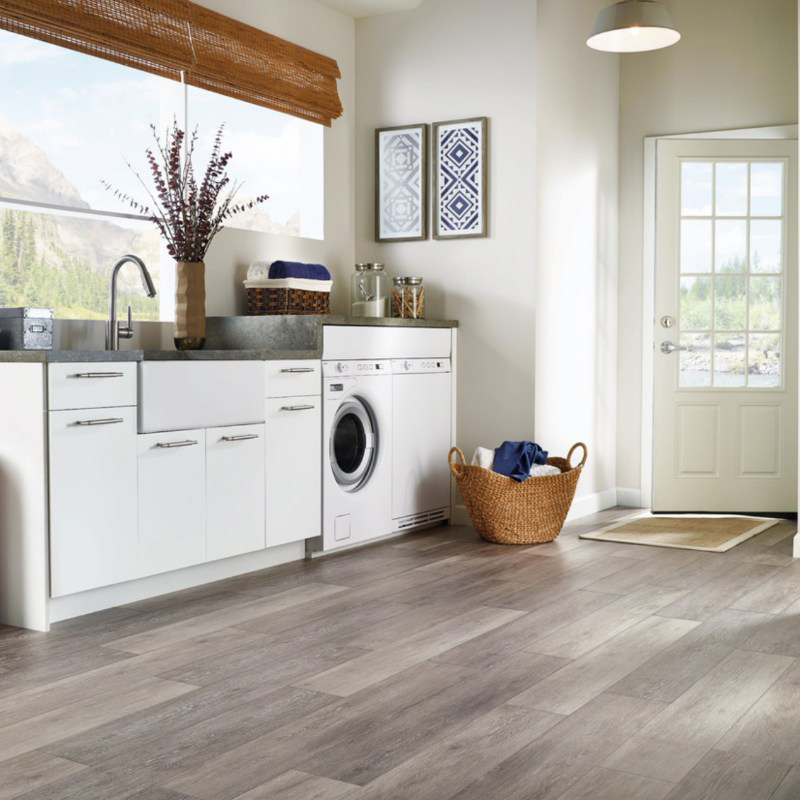How Do Laminate And Vinyl Flooring Differ?
October 31, 2019
For homeowners who love the look of hardwood floors but want something bit more durable and practical, laminate and vinyl flooring are both popular choices. They look similar, at least at first glance. So similar, in fact, that people think choosing between the two is going to be a tough choice.
In the past, comparing vinyl and laminate might have been reasonable. However, technology has changed that, and today’s vinyl flooring has evolved. When we compare the two products, we can see that there are striking differences.
Composition
When we describe modern vinyl flooring, we’re referring to Luxury Vinyl Flooring (LVT). Its composition is roughly the same as standard vinyl flooring, with four layers bonded together. What sets LVT apart, however, is the thickness of these layers. The top layer is a polyurethane coating that protects the tile from scratches, scuffs, stains, and other damage. The second layer is a clear film that adds even more protection to the third layer beneath, which consists of the photographic layer that creates the stone or wood look. Underneath it all is the fourth layer, the heavy-duty vinyl backing that gives LVT its rigid, solid property.
Laminate flooring, on the other hand, is composed of mostly fiberboard which is held together by a melamine resin. The top polyurethane coating protects the core of the flooring and the second, photographic level that mimics wood grain or stone.

Photo Credit: Houzz
Water Resistance
One of the reasons homeowners steer clear of hardwood flooring is how easy it can be damaged by liquids and humidity. Even a small amount of water can discolor the wood or even cause it to deteriorate and warp. So, is laminate or vinyl flooring a better choice for areas that may be wet or experience spills?
Laminate flooring is mostly made of wood products. Although it does have a protective layer, it is not waterproof. Moisture can get in between unsealed cracks and the spaces between each plank and cause it to discolor or swell. For this reason, laminate is not recommended for areas such as bathrooms, laundry rooms, or kitchens.
Vinyl plank flooring is waterproof. Its construction and protective layer can stand up to spills, puddles, stains, and humidity. Not only is it a great choice for bathrooms and kitchens, but it’s also pet-friendly. Even the best-trained pets have accidents sometimes or run through the house with muddy paws. With this modern tile, you have no need to worry about damage.
Durability
A top-quality laminate floor can last up to 20 years, but its typical lifespan is about 10 years before it needs to be replaced due to signs of wear. Over time its protective layer will wear down or become scratched, and it will start to look dingy and dull. Aside from regular mopping, there isn’t much you can do to extend its life.
LVT typically comes with a 15-year warranty for residential use — sometimes it even has a lifetime warranty. It’s not indestructible, but with proper care LVT can last for decades and still look fresh and beautiful.

Variety of Wood Looks
Both laminate and vinyl flooring are available in many different patterns that resemble wood grain, laminate flooring tends to look a bit artificial. Modern, high-tech LVT, on the other hand, looks so authentic that you’ll think it’s the real thing.
The variety of vinyl tile that looks like wood is astonishing. You can choose between subtle pale flooring that resembles ash or pine, or go for a bolder look with distinctive patterns of graining that even include wood knots. If your home is decorated with a rustic or cottage style, you may choose an LVT that resembles reclaimed barn wood — weathered, faded, with just a touch of color.
Feel Underfoot
Families, especially those with young children, may be concerned about how their flooring feels underfoot. Will it be hard and cold, or warm and pleasant for bare feet?
Laminate flooring has been considered the winner over vinyl flooring when it comes to the feel underfoot, due to its mostly wooden composition and thicker construction. Vinyl tile, however, has come a long way since its introduction. Today’s LVT is thicker, which gives it more of an authentic wood-floor feel underfoot and makes it quieter to walk on.
Another bonus for LVT is that it can be installed with under-floor radiant heating systems. This is a great way to keep your toes warm in the winter, especially in bathrooms and bedrooms. Under-floor heating can also help cut your utility bills because it’s an efficient way to heat your home.
Price and Installation Cost
If your only concern is saving money, laminate may be your best choice. A good quality laminate floor costs about $3 to $5 per square foot. LVT’s cost ranges from $5 to $7. Both are relatively easy to install, and can be DIY projects.
Consider, however, that LVT lasts much longer than laminate. So, while it may cost less upfront, you’ll make up the difference over time.

Photo Credit: Houzz
Resale Value / Return on Investment
Whether you are planning to sell your home soon or plan to stay for several years, it’s still a good idea to consider your return on investment, when it comes to resale value, when planning a home renovation project. Laminate flooring may look great at first, but it will always look a bit artificial compared to real hardwood flooring and may actually decrease your home’s value.
Due to its authentic look and feel, and the fact that LVT lasts for 20 years or more, potential home buyers will be impressed, as will the house appraisers who help to set its market value.
Environmental Impact
In addition to all the factors mentioned already, many homeowners are concerned about the environmental impact of their flooring and its contribution to maintaining healthy indoor air quality.
Laminate is made mostly of wood, which makes it a mostly recyclable product. Some brands are even manufactured with recycled wood. LVT is not typically recyclable, although some facilities may be able to do so. On the other hand, LVT lasts much longer, so it contributes to the production of less waste altogether.
As you can see, both laminate and luxury vinyl tile have properties that make them wise choices for homeowners. However, since vinyl flooring has had many technological improvements over the years, it has the edge when it comes to long-term value and beauty.
Learn More About Luxury Vinyl Tile
How Do You Clean Vinyl Plank Flooring?
Got Trim? A Guide to Everlife Luxury Vinyl Flooring Accessories
The Definitive Guide to Luxury Vinyl Tile
Luxury Vinyl Tile – The Wilmont Series